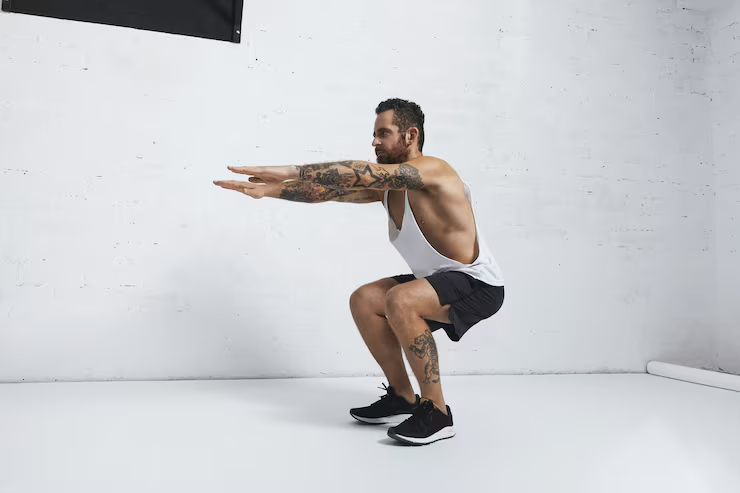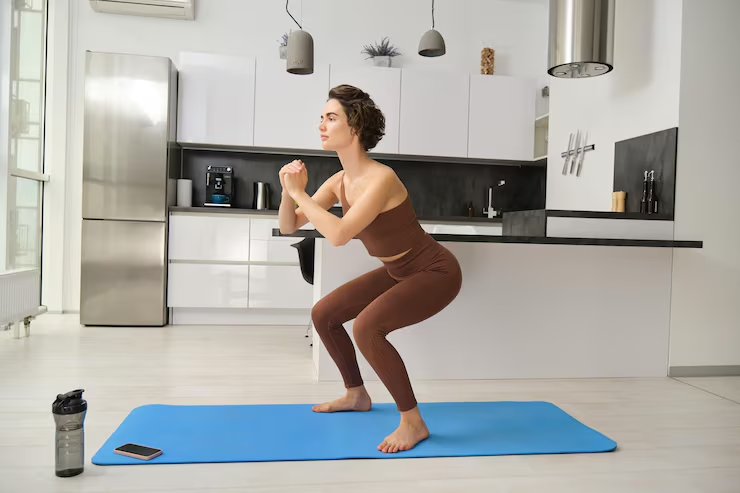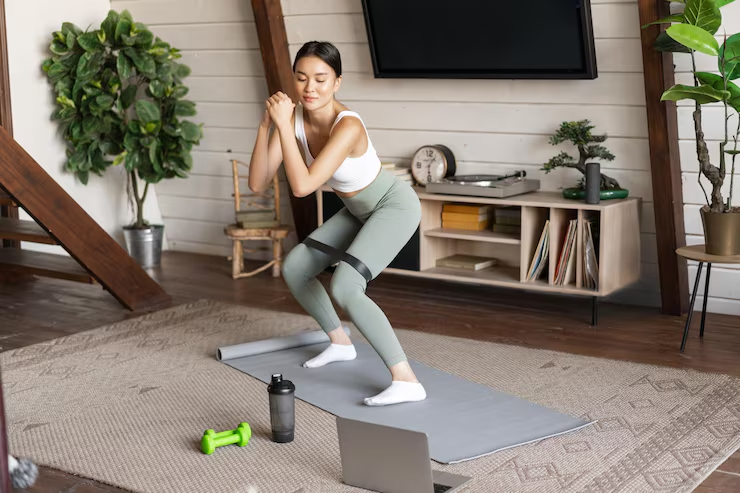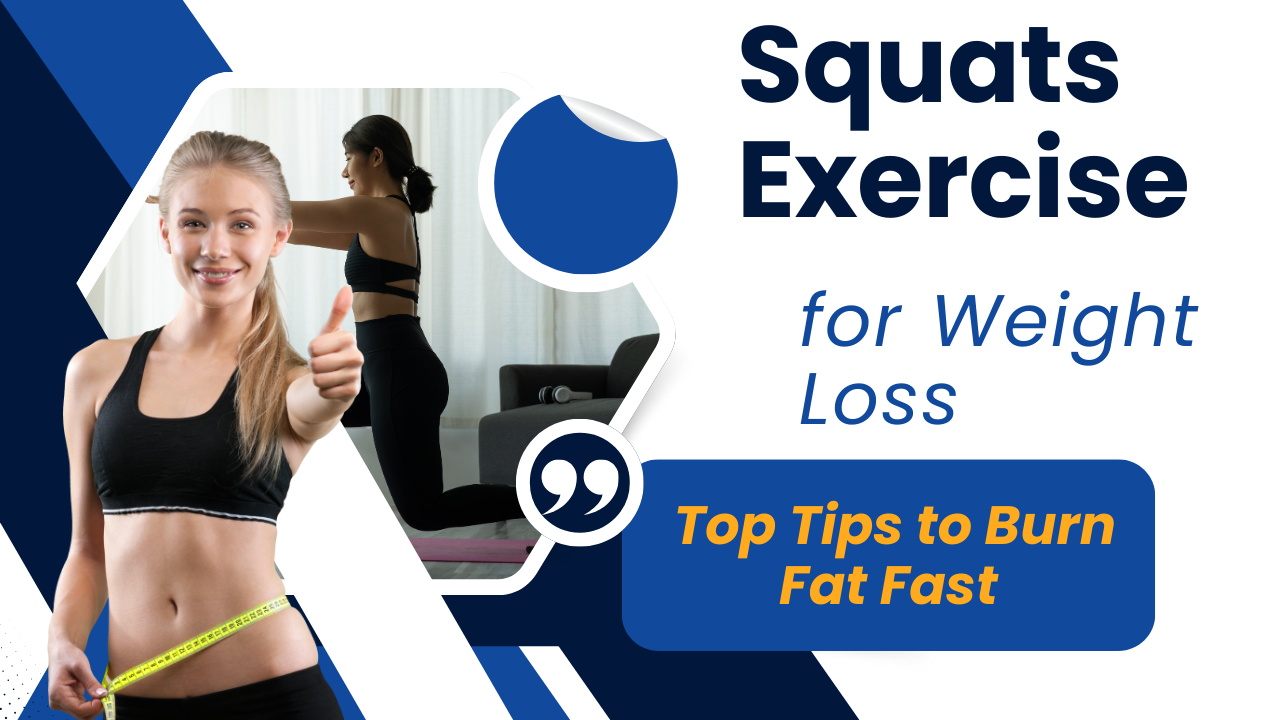Squats are a fundamental exercise that engages multiple lower-body muscles, making them one of the most effective workouts for weight loss. Unlike isolation exercises, squats target the quads, glutes, hamstrings, and core simultaneously, which increases calorie expenditure and boosts metabolism. Incorporating squats exercise for weight loss into your routine can accelerate fat reduction, improve posture, and strengthen joints.
Beyond just fat loss, squats enhance functional strength, balance, and flexibility. They mimic everyday movements such as sitting and standing, improving mobility and overall body coordination. Whether performed at home, in the gym, or outdoors, squats exercise for weight loss is adaptable for beginners and advanced athletes alike, with countless variations to challenge muscles in new ways.
Consistency and proper form are key to achieving results. When combined with a balanced diet and progressive intensity, squats exercise for weight loss not only sculpts the lower body but also promotes total-body fat loss. With the right approach, this simple yet powerful exercise can transform your physique, health, and confidence.
What Are Squats?
Squats are compound movements involving hip and knee flexion while keeping the spine neutral. They simulate the natural action of sitting and standing, making them both functional and efficient. Performing squats exercise for weight loss engages the quadriceps, hamstrings, glutes, and core, producing high energy expenditure and calorie burn.
Adding variations or resistance, such as dumbbells, kettlebells, or a barbell, further increases intensity and muscle activation. Bodyweight squats are ideal for beginners, while jump squats or weighted squats challenge the body for advanced fat-burning results. The adaptability of squats exercise for weight loss allows anyone to incorporate them into their routine safely and effectively.
The versatility of squats ensures consistent engagement of multiple muscle groups. Over time, regular practice improves muscle endurance, stimulates metabolism, and promotes lean muscle development. With the proper form, squats exercise for weight loss also strengthens ligaments, tendons, and stabilizing muscles, reducing the risk of injury in daily activities and sports.
Why Squats Are Effective for Weight Loss
Squats are highly effective for fat loss because they engage large muscle groups that require more energy, increasing calorie expenditure during and after exercise. By performing squats exercise for weight loss, the body experiences a hormonal response, releasing growth hormones that facilitate fat reduction and muscle building.
Squats also improve metabolic rate by increasing lean muscle mass. More muscle tissue requires more calories to maintain, which helps burn fat even at rest. Regularly performing squats exercise for weight loss accelerates metabolism, enhances energy utilization, and aids in maintaining a calorie deficit.
Additionally, squats promote cardiovascular endurance when performed in high repetitions or as part of circuit workouts. This combination of strength and cardio training ensures maximum fat burning and overall health improvement. Integrating squats exercise for weight loss with proper nutrition and rest can yield significant results in body composition and fitness levels.
How Does Squats Exercise for Weight Loss Work?
Squats exercise for weight loss works by engaging multiple large muscle groups, including the quads, hamstrings, glutes, and core. When performed correctly, squats elevate heart rate and stimulate calorie burn, which contributes to overall fat loss. The compound nature of squats also boosts metabolism, as the body continues to burn calories even after the workout due to increased muscle activity.
In addition, squats exercise for weight loss strengthens the lower body and core, improving stability, posture, and functional fitness. Stronger muscles allow for higher intensity workouts and longer exercise durations, which enhance fat-burning efficiency. Combining squats with high-intensity intervals or cardio amplifies their effectiveness, making them a cornerstone for weight loss routines.
Finally, squats exercise for weight loss promotes fat reduction in targeted areas while toning the legs, glutes, and abdomen. Regular practice, combined with a balanced diet, ensures visible results, increased endurance, and improved overall body composition.
When to Do Squats Exercise for Weight Loss
Squats exercise for weight loss can be performed at any time of the day, depending on your schedule and energy levels. Morning sessions are ideal for jumpstarting metabolism, boosting energy, and setting a positive tone for the day. Performing squats in the morning also helps increase alertness and can improve mental focus throughout daily activities.
Evening workouts with squats exercise for weight loss are beneficial for relieving stress and burning calories accumulated during the day. After work or daily chores, doing squats can help release tension while strengthening and toning the lower body. Pairing squats with light cardio or stretching in the evening enhances fat-burning potential and promotes better muscle recovery overnight.
Frequency is more important than the exact timing when doing squats exercise for weight loss. Performing 3–5 sessions per week, gradually increasing intensity and reps, ensures effective fat loss, muscle toning, and improved overall fitness levels.
Top Tips: Squats Exercise for Weight Loss
Bodyweight Squats
Why it works: Bodyweight squats are one of the most foundational exercises for toning the lower body. They primarily target the quadriceps, hamstrings, and glutes while engaging the core for stability. Performing these squats consistently boosts metabolism and calorie burning, making them an essential part of any squats exercise for weight loss routine. Because no equipment is needed, they’re ideal for beginners and can be performed anywhere, providing accessibility and convenience. Over time, bodyweight squats improve lower-body strength and muscle endurance, which contributes to more efficient fat loss.
How to do it: Stand with feet shoulder-width apart, keep your chest upright, and core engaged. Lower your hips until your thighs are parallel to the floor, keeping knees aligned with toes. Push through your heels to rise back to standing. Repeat 15–20 times in controlled movements. Proper form ensures joint safety and maximizes muscle engagement, which is crucial for effective squats exercise for weight loss.
Benefits and tips: Bodyweight squats strengthen the legs, glutes, and lower back, while improving balance and mobility. Gradually increasing repetitions or adding variations like pause squats can enhance results. Maintaining correct posture prevents injuries and ensures consistent fat-burning progress as part of a squats exercise for weight loss program.
Jump Squats
Why it works: Jump squats combine cardio and strength training, making them excellent for high-intensity calorie burning. The explosive jump recruits fast-twitch muscle fibers, which increases metabolic rate and accelerates fat loss. This makes jump squats a perfect addition to any squats exercise for weight loss routine, as they not only tone the legs and glutes but also enhance cardiovascular fitness.
How to do it: Start in a standard squat stance with feet shoulder-width apart. Lower into a squat, then explosively jump upward, landing softly on the balls of your feet. Immediately descend into the next squat. Perform 10–15 reps per set, focusing on controlled landings to reduce stress on knees and ankles, ensuring a safe and effective squats exercise for weight loss session.
Benefits and tips: Jump squats strengthen the lower body, boost endurance, and improve overall stamina. They can be integrated into HIIT workouts or circuits for maximum fat burn. Keeping the core tight and chest upright throughout enhances results while protecting joints during squats exercise for weight loss.
Sumo Squats
Why it works: Sumo squats target the inner thighs, glutes, and hips due to the wider stance, engaging muscles differently than traditional squats. They increase calorie burn while improving lower-body strength, making them a great choice in squats exercise for weight loss routines. This variation helps in toning hard-to-target areas and enhances hip mobility and flexibility.
How to do it: Stand with feet wider than shoulder-width and toes slightly turned out. Lower into a squat, keeping your back straight and knees aligned with toes, then rise back up. Repeat 12–15 controlled reps. Focus on slow and deliberate movements to ensure proper form and avoid knee strain, maximizing the effectiveness of squats exercise for weight loss.
Benefits and tips: Sumo squats tone inner thighs, strengthen hips, and improve balance. Consistency with this variation improves fat metabolism and targets stubborn areas. Maintaining correct alignment and posture ensures safe practice as part of a squats exercise for weight loss program.
Bulgarian Split Squats
Why it works: Bulgarian split squats are a unilateral exercise that targets one leg at a time, increasing muscle activation and improving balance. This exercise strengthens the quads, hamstrings, and glutes, while also engaging the core. It is a highly effective addition to squats exercise for weight loss routines because unilateral training helps correct muscle imbalances and accelerates fat burning.
How to do it: Place one foot behind you on a bench or elevated surface. Lower your front leg into a squat while keeping your back straight and core engaged. Rise back up and repeat 10–12 reps for each leg. Focus on controlled movement and proper knee alignment over the ankle to prevent injury and maximize results in squats exercise for weight loss.
Benefits and tips: Bulgarian split squats improve stability, tone legs individually, and enhance fat-burning potential. Engaging the core throughout is crucial for balance and safety. Incorporate this variation in circuits for a more intensive squats exercise for weight loss session.
Goblet Squats
Why it works: Goblet squats increase resistance by holding a dumbbell or kettlebell at the chest, boosting calorie burn and muscle engagement. They target the legs, glutes, and core effectively, making them a valuable addition to squats exercise for weight loss routines. The added weight also improves posture and strengthens stabilizing muscles.
How to do it: Hold a dumbbell or kettlebell close to your chest, squat down until thighs are parallel to the floor, keeping chest upright and core tight. Push through your heels to return to standing. Repeat 12–15 reps, focusing on breathing and form to maximize the fat-burning benefits of squats exercise for weight loss.
Benefits and tips: Goblet squats build lower-body strength, enhance core stability, and accelerate fat loss. Exhaling on the upward movement and maintaining correct posture ensures efficiency. Including goblet squats regularly enhances any squats exercise for weight loss program.
Pistol Squats
Why it works: Pistol squats are single-leg squats that challenge balance, strength, and coordination. This advanced variation activates stabilizing muscles and burns calories efficiently, making it an excellent addition to squats exercise for weight loss routines.
How to do it: Extend one leg forward and lower your body on the other leg into a squat until your thigh is parallel to the floor. Keep your core tight and chest upright. Push through the heel of the supporting leg to return to the starting position. Alternate legs and repeat 8–10 times per side.
Benefits and tips: Pistol squats tone legs, strengthen the core, and improve balance. Beginners can use a wall or chair for support and gradually progress to full pistol squats. This ensures safe and effective squats exercise for weight loss.
Wall Sit Squats
Why it works: Wall sits are isometric exercises that continuously engage muscles, boosting endurance and fat burning. They target quads, glutes, and calves effectively while being low-impact, making them ideal for squats exercise for weight loss.
How to do it: Lean against a wall and slide down until knees are at a 90° angle. Hold this position for 30–60 seconds, keeping your back pressed against the wall and core engaged. Repeat 3–5 times.
Benefits and tips: Wall sits strengthen the lower body, improve stamina, and aid fat loss. Avoid rounding the back, engage the core, and increase hold duration progressively for maximum effect. This variation is a safe and efficient form of squats exercise for weight loss.
Weighted Barbell Squats
Why it works: Weighted barbell squats add resistance for maximum muscle activation, calorie burn, and strength building. This compound movement is one of the most effective squats exercise for weight loss variations for advanced fat loss and lean muscle development.
How to do it: Place a barbell across your shoulders, stand with feet shoulder-width apart, and lower into a squat until thighs are parallel. Push through heels to rise. Perform 8–12 reps per set.
Benefits and tips: Barbell squats strengthen legs, glutes, core, and back while boosting metabolism. Warm up properly, maintain a neutral spine, and use controlled movements to prevent injuries. Gradually increase weight to optimize fat-burning results of squats exercise for weight loss.
Benefits of Squats Exercise for Weight Loss
Boosts Metabolism: Squats engage large muscle groups, which increases calorie burn even at rest.
Strengthens Core and Lower Body: Tones quads, glutes, hamstrings, and calves while improving stability.
Improves Posture: Engaging core muscles during squats enhances spinal alignment and balance.
Enhances Fat Burning: Combining squats with cardio amplifies overall calorie expenditure.
Supports Functional Fitness: Squats mimic everyday movements, making daily activities easier and reducing injury risk.
Tips to Maximize Results
Combine with Cardio: Pair squats with running, cycling, or HIIT for faster fat loss.
Maintain Proper Form: Keep knees aligned with toes, chest upright, and core tight to prevent injuries.
Progress Gradually: Increase reps, sets, or weights over time for continuous muscle adaptation.
Incorporate Variety: Use bodyweight, jump, sumo, goblet, or weighted squats to target different muscles.
Conclusion
In conclusion, squats exercise for weight loss offers a comprehensive approach to burning calories, building lower-body strength, and enhancing overall fitness. From basic bodyweight squats to advanced weighted or pistol variations, each form targets multiple muscle groups while promoting fat loss. Incorporating squats into your workout routine ensures both strength development and effective calorie expenditure, making them a cornerstone of any weight-loss program.
Consistency and proper form are key to maximizing results with squats exercise for weight loss. Performing these exercises regularly, progressively increasing intensity, and combining them with cardiovascular training and a balanced diet accelerates fat reduction and toning. Maintaining correct posture protects joints and minimizes injury risk, ensuring safe and sustainable progress over time.
Ultimately, squats exercise for weight loss is versatile, adaptable for all fitness levels, and requires minimal equipment. Whether performed at home or in the gym, they deliver measurable results in toning the legs, glutes, and core while supporting overall fat-burning goals.
FAQs
1. How many squats should I do daily for weight loss?
For effective fat loss, aim for 3 sets of 15–20 repetitions daily. Beginners can start with bodyweight squats to perfect form, while advanced exercisers can add jump squats, goblet squats, or weighted squats. Ensure progressive overload by gradually increasing reps, sets, or resistance. Consistency matters more than intensity; daily engagement strengthens muscles, accelerates metabolism, and boosts calorie burn. Combining squats with other exercises and a balanced diet enhances overall fat loss.
2. Can squats alone reduce belly fat?
While squats exercise for weight loss effectively tones the lower body, they cannot target belly fat specifically. Spot reduction is a myth; overall fat loss is achieved through a combination of full-body workouts, cardio, and a calorie-controlled diet. Squats help build lean muscle, which increases resting metabolism and aids fat reduction across the body, including the midsection, over time.
3. Are weighted squats better for fat loss?
Yes. Adding resistance, like dumbbells or barbells, increases muscle engagement and calorie expenditure, making weighted squats a more effective option for fat burning compared to bodyweight squats alone. They also strengthen core, glutes, and legs more efficiently, improve posture, and boost overall strength. Start with moderate weight to ensure proper form and prevent injury.
4. How fast can I see results from squats?
With consistent effort and a balanced diet, noticeable improvements in muscle tone, strength, and fat loss typically appear within 4–6 weeks. Combining squats exercise for weight loss with cardio and healthy eating accelerates progress. Results vary based on age, metabolism, and fitness level, but sticking to a structured routine ensures sustainable improvements in body composition and endurance.
5. Can beginners perform jump squats safely?
Yes, but beginners should start with basic bodyweight squats to master form, build strength, and prevent joint strain. Once comfortable, progress to jump squats gradually, focusing on soft landings and controlled motion. Maintaining a tight core and upright posture reduces injury risk. Integrating jump squats into a structured routine of squats exercise for weight loss enhances calorie burn, improves stamina, and increases lower-body power safely.
